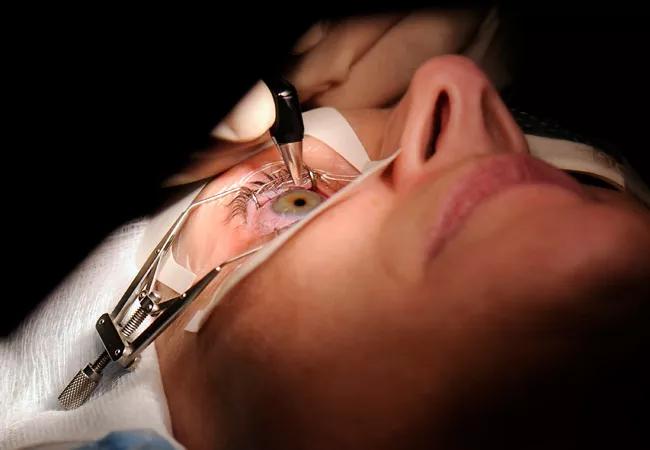LASIK causes twice as much corneal weakening as SMILE or PRK, shows study

With the prevalence of myopia significantly increasing and the prevalence of keratoconus much higher than previously believed, the need for direct, focal corneal biomechanical data in vivo is greater than ever. This data would contribute to more accurate laser vision correction surgeries and corneal cross-linking treatments for progressive keratoconus, as well as improve the laser vision correction screening process and early keratoconus detection. It also could allow surgeons to individualize corneal cross-linking treatment and more quickly pinpoint patients who are at risk of ectatic corneal disease.
Advertisement
Cleveland Clinic is a non-profit academic medical center. Advertising on our site helps support our mission. We do not endorse non-Cleveland Clinic products or services. Policy
Unfortunately, the devices currently available for analyzing corneal alterations have limited efficacy, “partly because it has been challenging to measure biomechanics in the living human eye,” says J. Bradley Randleman, MD, a cornea and refractive surgery specialist at Cleveland Clinic Cole Eye Institute.
As part of an NIH grant, Dr. Randleman’s research team developed a motion-tracking Brillouin microscope for in vivo corneal biomechanics mapping.
“Previous iterations of the Brillouin imaging device have been around,” he says. “The device has performed well in the lab, but it was not very accurate with in vivo measurements. We’ve made some significant upgrades, essentially creating a second-generation Brillouin microscopy device.”
One of the populations that Dr. Randleman’s ongoing prospective study is evaluating is postoperative refractive surgery patients.
“We have anticipated that we weaken the cornea with any refractive procedure, but how much is unclear,” he says. “And is there a difference in how much we’re weakening the cornea based on procedure?”
Dr. Randleman presented the initial results of the NIH-funded study at the 2022 American Academy of Ophthalmology annual meeting. Publication of results is pending.
The upgraded Brillouin microscope performed well in the study.
“The most important takeaway is that this microscopic device is extremely sensitive to changes after laser vision correction, which is the first time this has been shown,” says Dr. Randleman.
Using motion-tracking Brillouin imaging before laser vision correction and three months after, the study results showed no differences in group demographics or in preoperative Brillouin shift values between the groups.
Advertisement
However, the results showed meaningful differences in postoperative biomechanical change, including:
Dr. Randleman believed that SMILE would be midway between LASIK and PRK in terms of biomechanical change, so he was surprised that SMILE and PRK have similar impacts.
“This is a very small study thus far, but if this turns out to be true over larger populations, it could allow patients to shift to SMILE instead of PRK for many of our cases,” he says.
Dr. Randleman hopes to be able to eventually identify two groups of patients with keratoconus — those just before experiencing vision loss and those more susceptible to developing postoperative corneal ectasia.
“We want to identify the people that need corneal cross-linking as early as possible, but we also want to avoid operating on people who are not optimal candidates for refractive surgery,” he says.
The primary reason for rejecting patients for laser vision correction is concern about their corneal strength. Because laser vision correction is elective, most surgeons are conservative in their screening, potentially rejecting candidates who actually may tolerate surgery well.
“If we have direct biomechanical information, we’ll screen a lot more people in than we do now, and we’ll help protect people who aren’t good surgery candidates,” says Dr. Randleman.
Ultimately, Dr. Randleman hopes to be able to tailor treatment to an individual’s preoperative biomechanical state to improve both safety and efficacy.
Advertisement
“We’re still many steps away from that, but this study is the first step in looking at what the procedures do in similar patient populations,” he says. “This is an ongoing project, so we’re also going to be looking directly at patients who are having cross-linking to see how much that impacts their cornea. Our goal is to expand that scope.”
Advertisement
Advertisement

New insights on effectiveness in patients previously treated with other anti-VEGF drugs

Evidence mounts that these diabetes and obesity drugs may protect eyes, not endanger them

Study identifies factors that may predict vision outcomes in diabetic macular edema

From medication to laser treatment to surgery

Prematurity is linked with poorer outcomes of retinal surgery in adulthood

For patients with headache, pulsatile tinnitus or vision changes, immediately stop use and refer to ophthalmology

Less than 50% of patients with diabetes get appropriate ophthalmic screening through primary care referrals

Study reveals more about the pathophysiology of Salzmann’s nodular degeneration